War of the Austrian Succession
The War of the Austrian Succession (German: Österreichischer Erbfolgekrieg, 1740–1748) involved most of the great powers and lesser powers of Europe over the issue of Maria Theresa's succession to the Habsburg Monarchy. The war included peripheral events such as King George's War (1744-1748) in British America, the War of Jenkins' Ear (which formally began on 23 October 1739), the First Carnatic War in India, the Jacobite rising of 1745 in Scotland, and the First and Second Silesian Wars.
The pretext for war was Maria Theresa's alleged ineligibility to succeed to the hereditary lands of her father, Emperor Charles VI, because Salic law precluded royal inheritance by a woman. This was to be the key justification for France and Prussia, joined by Bavaria, to challenge Habsburg power. Maria Theresa was supported by Great Britain, the Dutch Republic, Sardinia and Saxony.
Since 1739, Spain had been fighting the separate War of Jenkins' Ear with Great Britain, which primarily took place in the Americas. It joined the war in Europe, hoping to recapture its former possessions in Northern Italy, now held by Austria. Having previously re-gained the Kingdom of Naples in 1735, doing so would restore the territories lost under the 1713 Treaty of Utrecht.
The war ended inconclusively with the Treaty of Aix-la-Chapelle in 1748, because although Maria Theresa was confirmed as Archduchess of Austria and Queen of Hungary, it granted Prussia control of Silesia. The underlying issues were therefore not resolved; and combined with the political upheaval in Europe, this resulted in the Seven Years' War in which France and Great Britain swapped german allies. Traditional enmity between French and Habsburgs was put aside in an attempt to curb the rise of their new respective threats, Great Britain and Prussia.
Background
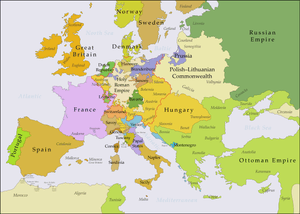
The immediate cause of the war was the death in 1740 of Emperor Charles VI (1685–1740), and the inheritance of the Habsburg Monarchy, often collectively referred to as Austria (see map). The 1703 Mutual Pact of Succession agreed that if the Habsburgs became extinct in the male line, their possessions would go first to female heirs of Joseph, then those of Charles. Since Salic law excluded women from the inheritance, this required approval by the various Habsburg territories and the Imperial Diet.[3]
When Emperor Joseph I died in 1711, he left two daughters, Maria Josepha and Maria Amalia, and Charles became the last male Habsburg. In April 1713, he issued the Pragmatic Sanction, permitting female inheritance but then placing his own hypothetical daughters ahead of Joseph's.[4]
The birth of Maria Theresa in 1717 ensured that her succession dominated the rest of Charles' reign.[5] In 1719 Charles required his nieces Maria Josepha and Maria Amalia to renounce their rights in Maria Theresa's favour in order to marry Frederick Augustus of Saxony and Charles Albert of Bavaria respectively. Charles hoped these marriages would secure his daughter's position, since neither Saxony nor Bavaria could tolerate the other gaining control of the Habsburg inheritance, but his actions undermined the logic of the settlement.[6]
A family issue became a European one due to tensions within the Holy Roman Empire, caused by dramatic increases in the size and power of Bavaria, Prussia, and Saxony, mirrored by the post-1683 expansion of Habsburg power into lands previously held by the Ottoman Empire. Further complexity then arose from the fact that the theoretically elected position of Holy Roman Emperor had been held by the Habsburgs since 1437. These were the centrifugal forces behind a war that reshaped the traditional European balance of power; the various legal claims were largely pretexts and seen as such.[7]
Bavaria and Saxony refused to be bound by the decision of the Imperial Diet, while in 1738 France agreed to back the 'just claims' of Charles Albert of Bavaria, despite previously accepting the Pragmatic Sanction in 1735.[8] Attempts to offset this involved Austria in the 1734-1735 War of the Polish Succession and the Russo-Turkish War of 1735–1739, and it was weakened by the losses incurred. Compounded by the failure to prepare Maria Theresa for her new role, many European statesmen were sceptical Austria could survive the contest that would follow Charles' death, which finally occurred in October 1740.[9]
Military overview and strategies
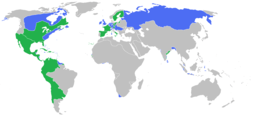
The war can be divided into three connected but distinct conflicts. First, the Silesian Wars between Austria and Prussia over control of Silesia. Second, France aimed to weaken Austria in Germany, while Spain sought to recapture territories in Italy lost to Austria after the War of the Spanish Succession. Third, Britain fought with France in an increasingly global contest for imperial supremacy. In the end, French conquest of the Austrian Netherlands gave them clear dominance on land, while Britain's naval victories made it even more dominant at sea.[10]
For much of the eighteenth century, France approached its wars in the same way: It would either let its colonies defend themselves, or would offer only minimal help (sending them only limited numbers of troops or inexperienced soldiers), anticipating that fights for the colonies would likely be lost anyway.[11] This strategy was, to a degree, forced upon France: geography, coupled with the superiority of the British navy, made it difficult for the French navy to provide significant supplies and support to French colonies.[12] Similarly, several long land borders made an effective domestic army imperative for any ruler of France.[13] Given these military necessities, the French government, unsurprisingly, based its strategy overwhelmingly on the army in Europe: it would keep most of its army on the European continent, hoping that such a force would be victorious closer to home.[13] At the end of the War of Austrian Succession, France gave back its European conquests, while recovering such lost overseas possessions as Louisbourg, largely restoring the status quo ante as far as France was concerned.[14]
The British tried to avoid large-scale commitments of troops on the Continent.[15] They sought to offset the disadvantage this created in Europe by allying themselves with one or more Continental powers whose interests were antithetical to those of their enemies, particularly France. In the War of the Austrian Succession, the British were allied with Austria; by the time of the Seven Years' War, they were allied with its enemy, Prussia. In contrast to France, once Britain became engaged in the war, it took advantage of the Royal Navy to expand it into the colonies.[16] The British pursued a dual strategy of naval blockade and bombardment of enemy ports, and also utilized their ability to move troops by sea to the utmost.[17] They would harass enemy shipping and attack enemy outposts, frequently using colonists from nearby British colonies in the effort. This plan worked better in North America than in Europe, but set the stage for the Seven Years' War.
Methods and technologies
European warfare in the early modern period was characterised by the widespread adoption of firearms in combination with more traditional bladed weapons. Eighteenth-century European armies were built around units of massed infantry armed with smoothbore flintlock muskets and bayonets. Cavalrymen were equipped with sabres and pistols or carbines; light cavalry were used principally for reconnaissance, screening and tactical communications, while heavy cavalry were used as tactical reserves and deployed for shock attacks. Smoothbore artillery provided fire support and played the leading role in siege warfare.[18] Strategic warfare in this period centred around control of key fortifications positioned so as to command the surrounding regions and roads, with lengthy sieges a common feature of armed conflict. Decisive field battles were relatively rare, though they played a larger part in Frederick's theory of warfare than was typical among his contemporary rivals.[19]
The War of the Austrian Succession, like most European wars of the eighteenth century, was fought as a so-called cabinet war in which disciplined regular armies were equipped and supplied by the state to conduct warfare on behalf of the sovereign's interests. Occupied enemy territories were regularly taxed and extorted for funds, but large-scale atrocities against civilian populations were rare compared with conflicts in the previous century.[20] Military logistics was the decisive factor in many wars, as armies had grown too large to support themselves on prolonged campaigns by foraging and plunder alone. Military supplies were stored in centralised magazines and distributed by baggage trains that were highly vulnerable to enemy raids.[21] Armies were generally unable to sustain combat operations during winter and normally established winter quarters in the cold season, resuming their campaigns with the return of spring.[18]
Silesian Campaign of 1740

At the age of 28, Frederick II succeeded his father Frederick William as king of Prussia on 31 May 1740.[22] Although Prussia had increased in importance over the past few decades, its disparate and scattered territories prevented it wielding significant power and Frederick intended to change this.[22] The death of Emperor Charles VI on 20 October 1740 provided an opportunity to acquire Silesia but he needed to do so before Augustus of Saxony and Poland could pre-empt him.[23]
Thanks to Frederick William and Leopold of Anhalt-Dessau, the Prussian army was better trained and led than its opponents.[24] It had largely avoided recent combat, making it something of an unknown factor, while its standing army of 80,000 was disproportionately large, at around 4% of its 2.2 million population.[25] With a population of 16 million, Austria had an authorised standing force of 157,000, although financial restraints meant its true size was considerably less than that in 1740.[26] Since they had a much greater area to defend, their army was more of "a sieve" than a shield against foreign invasion.[27]
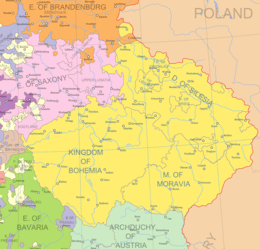
To add to these qualitative advantages, Frederick ensured a two front war through a secret treaty with France in April 1739, which agreed France would attack Austria from the west, while Prussia did so from the east.[28] In early December 1740, the Prussian army assembled along the Oder river and on 16 December, invaded Silesia without a formal declaration of war.[29]
Austrian military resources were concentrated in Hungary and Italy, and they had fewer than 3,000 troops in Silesia, although this was increased to 7,000 shortly before the invasion. They held onto the fortresses of Glogau, Breslau, and Brieg, but abandoned the rest of the province and withdrew into Moravia, and both sides went into winter quarters.[30]
This campaign gave Prussia control of most of the richest province in the Habsburg Empire, containing a population of over one million, the commercial centre of Breslau, along with mining, weaving and dyeing industries.[31] However, Frederick underestimated Maria Theresa's determination to reverse her loss, while the retention of Austrian fortresses in Southern Silesia meant a quick victory could not be achieved.[32]
Allies in Bohemia 1741
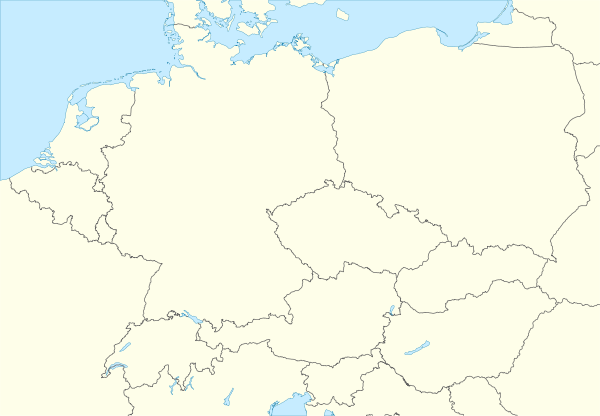
Early in the year, an Austrian army under von Neipperg relieved Neisse, and marched on Brzeg, threatening to cut the Prussians off. On 10 April, just outside Brzeg, they were defeated at the Battle of Mollwitz; Frederick made serious mistakes in his first battle, and was so close to defeat, his subordinates ordered him from the field, to avoid capture. His deputy von Schwerin managed to drag out a victory, both sides losing nearly 25% of their strength.[33]
On 5 June, Frederick signed an alliance against Austria with France, who crossed the Rhine on 15 August. [34] A combined Franco-Bavarian force now advanced along the Danube, towards Vienna, capturing Linz on 14 September.[35] Joined by a Saxon army of 20,000, they advanced on Prague from three different points, initially meeting little resistance. Before long, the Austrians had an army at Tábor, while Neipperg was recalled from Silesia to defend Vienna.[36]
Apparently close to defeat, on 21 September Maria Theresa made an emotional speech to the Hungarian Diet in Pressburg. They approved a levée en masse, which ultimately produced 22,000 troops, rather than the promised 60,000, but was an assertion of loyalty long remembered.[37]
She was also helped by the level of hostility between her opponents, and the duplicity of Frederick.[38] Hoping to weaken Saxony, on 9 October, Frederick signed the Klein–Schnellendorf agreement with Neipperg; in a now notorious piece of diplomatic subterfuge, the Austrians surrendered Neisse after a mock defence. Under the prevailing rules of war, this allowed them to receive a pass to the nearest friendly territory, and thus be used against Prussia's allies, rather than being taken prisoner.[39] Her best general, von Khevenhüller incorporated them into an army being assembled for a winter offensive to retake Upper Austria, and attack Bavaria.[40]
While Frederick completed his conquest of Silesia, a French force under Maurice de Saxe took Prague on 26 November 1741; the Bavarian elector, Charles VII was crowned King of Bohemia. The year ended with Khevenhüller advancing up the Danube towards Linz, while a second column under Johann Bärenklau moved through the Tyrol, towards Munich.[40]
Campaigns of 1742
On 17 January, von Khevenhüller defeated a Bavarian army at Schärding; a week later, 10,000 French soldiers surrendered at Linz. Charles became the first non-Habsburg Emperor in 300 years on 12 February, the same day Bärenklau captured his capital, Munich. Technically allies, neither Prussia, Saxony, or Bavaria had any desire to see France established in the Empire, or any of the others gain ground. Maria Theresa ended the truce with Frederick, first releasing the details; the Austrians assembled a second army of 28,000 to retake Prague, under Charles of Lorraine.[41]
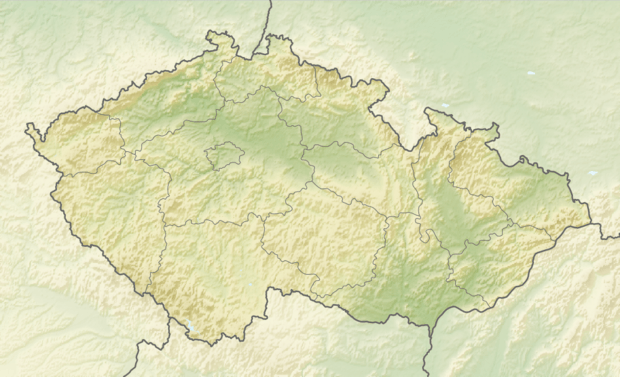
News of the secret truce badly damaged the relationship between Frederick and his allies, but Emperor Charles asked him to relieve the pressure by invading Moravia. Frederick had used the interval to reorganise his cavalry, previously neglected in favour of the infantry, and who performed poorly at Mollwitz; they would prove more effective in the 1742 campaign.[42]
In December 1741, von Schwerin had captured Olomouc; Frederick took Kłodzko, before moving onto Židlochovice in March 1742. This allowed him to threaten Vienna; a few Prussian patrols even appeared in the suburbs, before withdrawing.[43] In early May, he took the offensive, and moved into North-East Bohemia; by 16 May, he had 10,000 infantry at Kutná Hora, with 18,000 men under Leopold of Anhalt-Dessau a day's march behind.[44]
On the afternoon of 16 May, Charles' cavalry ran into Leopold's rearguard; recognising he was in contact with the Austrian main force, Leopold accelerated his march to close the gap with Frederick. At 2:00 am on 17 May, his exhausted troops stopped at the small village of Chotusice, three hours march from Kutná Hora.[45] Fought later the same day, the Battle of Chotusitz was inconclusive, but technically a Prussian victory, since the Austrians withdrew. On 24 May, French Field Marshal de Broglie won a minor action at Zahájí. The two victories left the strategic situation unchanged, since Charles was still able to move against Prague, while the Prussian presence in Moravia remained a threat to Vienna.
However, Habsburg policy was generally to avoid fighting on too many fronts at the same time; Prussia was the most dangerous, and most difficult to defeat. Although recovering Silesia remained a priority for decades, Maria Theresa was willing to agree a temporary truce with Prussia to improve her position elsewhere.[46] This suited Frederick, who was short of money and men and also suspected France was preparing a separate peace. In June, the Treaty of Breslau ended the First Silesian War; Prussian troops withdrew from Bohemia, and Austria recaptured Prague in December.[47]
Campaign of 1743

At the beginning of the year, Louis XV insisted Broglie be given command of the Franco-Bavarian forces, creating tension with the Bavarians, and their general von Seckendorff.[48] With most of his lands occupied by the Austrians, Charles VII fled to Augsburg, from where he initiated talks with Vienna and London, feeling he had been abandoned by his French allies.[49] Divided at the top, and their troops weakened by disease, the Franco-Bavarian forces offered limited resistance to the Austrian advance; on 9 May, the Bavarians were defeated outside Simbach, by Charles of Lorraine.[50]
In mid-June, the Pragmatic army arrived at Aschaffenburg, on the north bank of the River Main. Here they were joined by George II, who was attending the coronation of a new Elector of Mainz in Wiesbaden.[51] By late June, the Allies were running short of supplies; the nearest depot was at Hanau, the road to which ran through Dettingen. Here, French commander, the duc de Noailles, positioned 23,000 troops under his nephew, the duc de Gramont, whose mistakes prevented an Allied defeat.[52]
While the Pragmatic Army were able to continue their retreat, they had to abandon their wounded, and although reinforced by Charles of Lorraine, they were unable to agree what to do next. Charles later described Allied headquarters as a 'republic', while Noailles told Louis XV he was 'heavily indebted to the irresolutions of George II.' They ended by doing nothing, and in October, took up winter quarters in the Netherlands.[53]
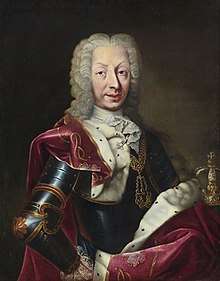
Frederick had responded to Dettingen by renewing his search for allies, and building up his army once again. In July, the Russian court discovered an alleged plot to overthrow Tsarina Elisabeth, and restore three year old Ivan VI, with his mother Grand Duchess Leopoldovna as his regent.[54] Whether this amounted to anything more than drunken gossip is disputed; one suggestion is that it was a fabrication by Frederick, designed to remove anti-Prussian opponents, chiefly Chancellor Bestuzhev-Ryumin.[55]
Anna Bestuzhev, wife of his brother Mikhail, and her friend Natalia Lopukhina, confessed to the plot after 25 days of torture; they were publicly flogged, and had their tongues removed before being exiled to Siberia. Fredrick's supporters referred to it as the "Botta Conspiracy", after Austrian envoy Antoniotto Botta Adorno, who was also accused of involvement.[56] When Tsarina Elizabeth demanded Botta be punished, Maria Theresa refused, and the episode poisoned the relationship between Austria and Russia. Frederick managed to divide his two main opponents, but since Bestuzhev-Ryumin remained in place, it left the overall position unchanged.[55]
On 13 September, Charles Emmanuel III of Sardinia, Maria Theresa and Britain agreed the Treaty of Worms, aimed at the expulsion of Spain from Italy. In return for Sardinian support in Lombardy, the Austrians ceded all their territories west of the Ticino River and Lake Maggiore, along with lands south of the Po River. In return, Charles Emmanuel renounced his claim to the strategic Duchy of Milan, guaranteed the Pragmatic Sanction, and provided 40,000 troops, paid for by Britain.[57]
France and Spain responded with the Second Pacte de Famille in October, and Louis XV began plans to invade the Austrian Netherlands. The year ended with Saxony agreeing a pact of mutual defence with Austria, leaving Prussia isolated, and facing a renewed offensive as Maria Theresa sought to regain Silesia.[58]
Campaign of 1744

The Second Silesian War began in 1744. Frederick of Prussia was disquieted by the universal success of the Austrians and their alliance with Sardinia. Accordingly, he secretly concluded another alliance with Louis XV of France.[59] France had posed hitherto as an auxiliary—its officers in Germany had worn the Bavarian cockade—and was officially at war only with Britain. France now declared war directly upon Austria and Sardinia (April 1744).[60]
At this point, the French planned a diversion that they hoped would cause Britain to leave the war. A French army was assembled at Dunkirk to support the cause of Charles Edward Stuart (Bonnie Prince Charlie) in an invasion of Great Britain. Prince Charles was son of James Francis Edward Stuart, Stuart pretender to the British throne, who was the son of James II the last Catholic and last Stuart king of England. James II had been deposed as the King of England in 1688 in favour of his daughter, Mary, and her husband the Protestant Prince of Orange, William III of the house of Orange-Nassau. A significant element of the British population still hoped for the return of the Stuart family as monarchs. Louis XIV of France had shown great support for Stuart cause. Indeed, in 1715, France had sponsored an uprising in Scotland, which the pretender James had joined, but it was defeated. Forbidden to return to France by the new king, Louis XV, James sought sanctuary elsewhere. Finally, Pope Clement XI offered James and his family the use of Palazzo Muti and a lifetime annuity of 8,000 Roman scudi. Charles Edward Stuart was born and lived his whole life in the Palazzo Muti.
Charles had much more charisma than his father, and now Louis XV was favourably disposed toward helping him create another uprising in Scotland. Louis XV sent Drummond of Balhaldy as an emissary to the Stuart "court" in Rome.[61] French plans called for Charles to be in Dunkirk, France, to assemble with the fleet on 10 January 1744, yet Balhaldy had only arrived in Rome on 19 December 1743.[61] Thus there was very little time to waste. On 23 December 1743, Charles' father named him "Prince Regent" so that Charles could act in his own name. In the spring of 1744, Prince Charles secretly arrived in France and was about to board the ships that would take him to England. However, on the night before he was to board, a fierce storm blew up (this storm became known as the "Protestant Wind") and wrecked or dispersed the entire fleet.[62] The violent storms had wrecked the crossing attempt, and the planned invasion was abandoned. However, Charles did not give up hope of restoring the Stuart family to the throne of England.
During naval operations that were possible preparations for a coordinated French invasion of England, the largest sea battle of the war occurred, on 22 February 1744.[63] This naval battle took place in the Mediterranean off the coast of Toulon, France. A large British fleet under the command of Admiral Thomas Mathews, with Rear Admiral Richard Lestock second in command, was blockading the French coast. A smaller French and Spanish naval force attacked the British blockade and damaged some of the British ships, forcing the British to withdraw and seek repairs. Thus, the British blockade of the French coast was relieved, and the Spanish fleet apparently controlled the Mediterranean Sea. A Spanish squadron took refuge in the harbour at Toulon. The British fleet watched this squadron carefully from a harbour a short distance to the east. On 21 February 1744, the Spanish ships put to sea with a French fleet. Admiral Mathews took his British fleet and attacked the Spanish fleet from 22 February until 23 February 1744 in what has become known as the Battle of Toulon. However, the smaller Spanish fleet was allowed to escape. With the knowledge that a larger French fleet was sailing to the rescue, the British ships broke off combat and retreated to the northeast.
Although technically the Battle of Toulon was regarded as a victory for Britain,[64] in Britain the public feared that the combined French and Spanish ships were making for the Strait of Gibraltar and for a gathering of ships at Brest for a planned invasion of England.[64] As a consequence, bitter recriminations were brought against Admiral Mathews for letting this Spanish-French fleet get away and, subsequently, placing England in danger of invasion. Consequently, both Mathews and Lestock were tried in naval court. Lestock was acquitted and Mathews was found guilty; some commentators regarded both decisions as injustices.[63]
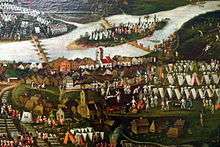
Meanwhile, on the battlefields in northern Europe, Louis XV in person, with 90,000 men, invaded the Austrian Netherlands[65] and took Menin and Ypres in July 1744.[66] His presumed opponent, although shorn of the Russians, still consisted of the same allied army, previously commanded by King George II, and composed of British, Dutch, German (Hanoverian) and Austrian troops.
The French put four armies into the field.[67] On the Rhine, Marshal Coigny had 57,000 troops up against 70,000 allied troops under the command of Prince Charles.[68] A fresh army of over 30,000 soldiers under the Prince de Conti was located between the Meuse and Moselle rivers, which would later assist the Spaniards in Piedmont and Lombardy.[67] This plan was, however, at once dislocated by the advance of Prince Charles, who, assisted by the veteran Marshal Traun, skillfully manoeuvred his allied army over the Rhine near Philippsburg on 1 July 1744 and captured the lines of Weissenburg, and cut off Marshal Coigny and his army from Alsace.[69]
A third French Army composed of 17,000 men under the command of Duke d' Harcourt kept Luxembourg at bay[67] Meanwhile, the fourth French army was the largest army that put to field in the summer of 1744. This was the Army of Flanders, numbering 87,000 men and officially under the command of the king of France, Louis XV, but in actuality he was being militarily advised by Marshal Noailles.[67] As these French forces invaded the Austrian Netherlands, they outnumbered the allied armies by about a four to three ratio.[70] Furthermore, as they marched into the Austrian Netherlands, they met a confused resistance offered by Dutch forces.[71] Consequently, the French Army of Flanders made rapid progress across the Austrian Netherlands.[70] The situation became so desperate for the Dutch that the Dutch government sent an envoy to the king of France to seek peace. This plea for peace was rejected by the French.[70]
However, the situation in the Austrian Netherlands was changed abruptly by the successful crossing of the Rhine on 30 June 1744 by Prince Charles and his 70,000-man allied army.[70] Marshal Coigny, caught far in advance of the other French forces, cut his way back through the enemy at Weissenburg and withdrew towards Strasbourg.[72] Louis XV now abandoned the invasion of the Southern Netherlands, and his army moved down to take a decisive part in the war in Alsace and Lorraine.[73]
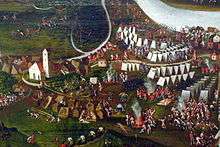
Finally, on 12 July 1744, Frederick II of Prussia received confirmation that Prince Charles had taken his army beyond the Rhine and into France.[72] Thus, Frederick knew that Prince Charles would not be able to present any immediate problem to him in the east. Consequently, on 15 August 1744, Frederick II crossed the Austrian frontier into Bohemia, and by late August all 80,000 of his troops were in Bohemia.[74] The attention and resources of Austria had been fully occupied for some time on a renewal of the war in Silesia. However, neither Maria Theresa nor her advisers had expected the Prussians to march as quickly as they did.[75] Accordingly, Frederick's invasion of Bohemia came as a surprise to the Austrian court and Frederick was almost unopposed in Bohemia. One column consisting of 40,000 troops, under Frederick's own command, passed through Saxony; another column of 16,000 men under the command of "Young Dessauer" passed through Lusatia, while a third consisting of 16,000 soldiers under Count Schwerin advanced from Silesia.[76] The destination for all three columns was Prague, and the objective was reached on 2 September. The city was surrounded and besieged. Six days later the Austrian garrison was compelled to surrender.[77] Scarcely had Prague surrendered to Frederick II than he was off marching southwards, leaving 5,000 soldiers under General Baron Gottfried Emanual von Einsiedel to garrison Prague.[78] Three days after the fall of Prague, Frederick seized Tabor, Budweis and Frauenberg.[79]
Maria Theresa once again rose to the emergency: a new "insurrection" took the field in Hungary, and a corps of regulars was assembled to cover Vienna. Meanwhile, Austrian diplomats won over Saxony to the Austrian side.[80] Because of Frederick's successful campaign in Bohemia, Prince Charles sought to withdraw from Alsace and cross the Rhine once again and strike at the Prussians. At this point the French had an excellent chance to strike at Prince Charles while he was in a vulnerable position, crossing the Rhine. However, the French military command was distracted and could not take any action, and Prince Charles was able to cross the Rhine once again unmolested by the French. The French had been unable to act because they were thrown into confusion by King Louis XV suddenly becoming very ill with smallpox at Metz.[76] The King's condition was so severe that many feared for his life. Only Count Seckendorf, commander of the Bavarians, pursued Prince Charles. No move was made by the French, and Frederick thus found himself isolated and exposed to the combined attack of the Austrians and Saxons. Count Traun, summoned from the Rhine, held the king in check in Bohemia with a united force of Austrians and Saxons. The Hungarian irregulars also inflicted numerous minor reverses on the Prussians. Finally Prince Charles arrived with the main army from the west. The campaign resembled that of 1742: the Prussian retreat was closely watched, and the rearguard pressed hard. Prague fell, and Frederick was completely outmanoeuvred by the united forces of Prince Charles and Count Traun.[81] Frederick was forced to retreat to Silesia with heavy losses. However, the Austrians gained no foothold in Silesia itself. On the Rhine, Louis XV, now recovered, had besieged and taken Freiburg,[82] after which the forces left in the north were reinforced and besieged the strong places of Southern Netherlands. There was also a slight war of manoeuvre on the middle Rhine.[83]
Campaign of 1745
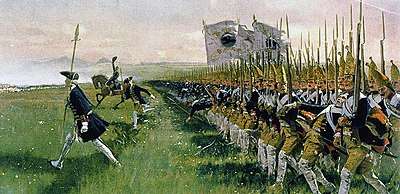
In 1745 three of the greatest battles of the war occurred: Hohenfriedberg, Kesselsdorf and Fontenoy. The formation of the Quadruple Alliance of Britain, Austria, the Dutch Republic and Saxony was concluded at Warsaw on 8 January 1745 by the Treaty of Warsaw.[84] Twelve days later on 20 January 1745, the death of the Holy Roman Emperor, Charles VII, submitted the imperial title to a new election.[82] Charles VII's son and heir, Maximilian III of Bavaria, was not even considered a candidate for the Imperial throne. The Bavarian army was again unfortunate. Caught in its scattered winter quarters (action of Amberg, 7 January), it was driven from point to point by a maneuver by the Austrian army under the joint command of Count Batthyány, Baron Bernklau and Count Browne. All Bavarian garrisons fled to the east. The Bavarian Army under the command of Count Törring was divided and paralyzed.[85] The French in the area under Count Ségur marched to save the day. Count Sègur's force out-numbered the Austrian army under Count Batthyany, yet Sègur and the French army were defeated at the Battle of Pfaffenhofen.[85] The young elector Maximilian III had to abandon Munich once more. The Peace of Füssen followed on 22 April 1745, by which Maximilian III secured his hereditary states on condition of supporting the candidature of the Grand-Duke Francis, consort of Maria Theresa. The "imperial" army ceased ipso facto to exist.[83]
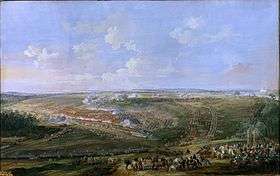
Frederick II of Prussia was again isolated. No help was to be expected from France, whose efforts at the time were centred on the Flanders campaign.[83] Indeed, on 31 March 1745, before Frederick took the field, Louis XV and the Marshal of France Maurice de Saxe, commanding an army of 95,000 men, the largest force in the war, had marched down the Scheldt valley and besieged Tournay.[86] Tournay was defended by a Dutch garrison of 7,000 soldiers.[87] In May 1745, a British army under the command of the Duke of Cumberland attempted to break the French siege and relieve Tournay. Maurice (who had just recently been appointed a Marshal in the French army) had very good intelligence and knew the road that Cumberland was using to attack his forces besieging forces. Thus, Maurice could select the battlefield. Maurice chose to attack the British allied army on a plain on the east side of the Scheldt river about two miles southeast of Tournay near the town of Fontenoy.[88] There the Battle of Fontenoy was fought on 11 May 1745. Fighting began at 5:00 AM with a French artillery barrage of the British-Allied forces, who were still attempting to move into their proper positions for their anticipated attack on Tournay. By noon, Cumberland's troops had ground to a halt and discipline had begun to dissolve. The British-Allied army sought cover in a retreat.[89] It was a victory for the French that captured the attention of Europe because it overturned the mystique of British military superiority, and it pointed out the importance of artillery.[90] On 20 June 1745, after the Battle on Fontenoy, the fortress of Tournay surrendered to the French.[91]
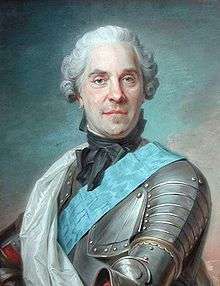
In the summer of 1745, the French once more decided to take up Charles Edward Stuart's claim to the British throne. The goal was to start a revolt in Scotland that would divert British attention away from the war on the mainland in Europe, and may even require Britain to leave the war altogether. On 23 July 1745, Charles landed on the island of Eriskay in the Hebrides, north-west of the mainland of Scotland.[92] On 25 July 1745, Charles set sail again for the mainland. By the end of August 1745, Charles had landed in Scotland and had started issuing calls for troops loyal to the Jacobite cause of placing him on the throne.[93] Already, Charles had collected 1,300 Scots prepared to fight in his Jacobite army.[93] Defence of the Hanoverian rule of King George II in Great Britain fell to General Sir John Cope, a veteran of the Battle of Dettingen. On 31 August 1745, Cope marched north with about 2,000 British government soldiers.[93] Charles reached Perth on 18 September 1745 and Edinburgh surrendered to him on 27 September 1745.[94] When Cope brought his army up to the town of Prestonpans, Scotland on 1 October 1745, he chose a stubble field that he felt was well protected on which to encamp his troops. However, it was not as safe as he thought, and at sunrise the next morning, 2 October 1745, Charles's Scottish troops attacked and defeated the British government army.[95] With the government army defeat at Prestonpans, it appeared that all Scotland belonged to Charles. By November 1745, his army consisted of 5,000 infantry men and 300 cavalry.[96] In mid-November 1745 it crossed the border from Scotland and invaded England.
As the Jacobite army moved south into England, Charles kept assuring his troops that aid and reinforcements from English Jacobites would be arriving at any time. This aide and reinforcements were desperately needed as the Jacobites were badly outnumbered by the three British government armies already in the field.[97] Finally on 6 December 1745, at Derby in the English midlands, Charles was reluctantly persuaded by his senior officers to turn back to Scotland.[98] Upon hearing about the turnabout in Derby, the French gave up on their plans for an invasion of England.[99] The Jacobites felt they could more securely fight the Hanoverians in a defensive battle on Scottish soil rather than fighting the British government army in England. On 17 January 1746, at the Battle of Falkirk Muir, 8,000 Scots, the largest number of troops gathered by the Jacobite cause during the uprising defeated 7,000 British troops.[100] Ultimately, however, Charles Stuart and his uprising were defeated on 27 April 1746 at the Battle of Culloden.[101]
The manoeuvres of the armies of both sides in the war on the upper Elbe occupied all the summer. Meanwhile, the political questions of the imperial election and of an understanding between Prussia and Britain were pending. The chief efforts of Austria were directed towards the valleys of the Main and of Lahn and Frankfurt, where the French and Austrian armies manoeuvred for a position from which to overawe the electoral body. Austrian Marshal Traun was successful, and, as a result, Francis, the husband/consort of Maria Theresa was elected Holy Roman Emperor on 13 September 1745. Frederick agreed with Britain to recognise the election a few days later, but Maria Theresa would not conform to the Treaty of Breslau of 1741, by which she had been forced to recognise Frederick's annexation of Silesia. Maria Theresa now tried a further appeal to the fortunes of war to get Silesia back. Saxony joined Austria in this last attempt to reconquer Silesia.[83]
In May 1745, The main Prussian army was stationed at Frankenstein. This army consisted of 59,000 soldiers and was fitted with 54 heavy cannons.[102] Frederick learned that a combined Austrian-Saxon army of about 70,000 troops under the command of Prince Charles, was on the march to the northeast towards Landeshut. To meet this threat to Silesia, Frederick II marched north toward Reichenbach. Before he reached Reichenbach, Frederick learned that Prince Charles was crossing the mountains from the west to the east side and that Prince Charles planned to occupy the town of Hohenfriedberg. Accordingly, Frederick encamped his army at Schweidwitz and waited for Prince Charles to come to him. At this site, Frederick laid a trap for the superior Austrian-Saxon forces. Indeed, Frederick was operating on the theory that "to catch a mouse, leave the trap open."[103] At 6:30 AM on 4 June 1745, while the Austrian-Saxon troops were still recovering from their long march, the trap was sprung on them in the Battle of Hohenfriedberg.[104] The Austrian-Saxon forces were no match for Frederick's army and especially his cavalry, and they lost half their artillery and almost a quarter of their men. At 9:00 AM, Prince Charles ordered a full retreat back toward Reichenberg.
A new advance of Prince Charles quickly led to the Battle of Soor on 30 September 1745, fought on ground destined to be famous in the Austro-Prussian War of 1866. Frederick commanded an army that at this time numbered only 20,000 soldiers in the vicinity of Soor. He was facing Prince Charles with an army of 41,000 troops.[105] He was at first in a position of great peril, but his army changed front in the face of the advancing enemy, and by its boldness and tenacity won a remarkable victory on 30 September 1745 at Soor.[83]
But the campaign was not ended. An Austrian contingent from the Main joined the Saxons under Field Marshal Rutowsky (1702–1764), and a combined movement was made in the direction of Berlin by Rutowsky from Saxony and Prince Charles from Bohemia. The danger was great. Frederick hurried his forces from Silesia and marched as rapidly as possible on Dresden, in Saxony. Frederick won the actions of Katholisch-Hennersdorf on 24 November 1745 and Görlitz on 25 November. Prince Charles was thereby forced to abandon his plans to attack Silesia and hurry back to defend Saxony. A second Prussian army under the Old Dessauer advanced up the Elbe from Magdeburg to meet Rutowsky. The latter took up a strong position at Kesselsdorf between Meissen and Dresden, but the veteran Leopold attacked him directly and without hesitation on 14 December 1745. The Saxons and their allies were completely routed after a hard struggle in the Battle of Kesselsdorf.[83] Leopold and Frederick then linked up their forces and took Dresden without a struggle. Maria Theresa was, at last, forced to give way. In the Treaty of Dresden signed on 25 December 1745, she recognised Frederick's annexation of Silesia, as first recognised in the Peace of Breslau in 1741. Frederick on the other hand recognised the election of Maria Theresa's husband/consort, Francis I, as the Holy Roman Emperor.
Italian Campaigns, 1741–47
.jpg)
In central Italy an army of Spaniards and Neapolitans was collected for the purpose of conquering the Milanese. In 1741, the allied army of 40,000 Spaniards and Neapolitans under the command of the Duke of Montemar had advanced towards Modena, the Duke of Modena had allied himself with them, but the vigilant Austrian commander, Count Otto Ferdinand von Traun had out-marched them, captured Modena and forced the Duke to make a separate peace.[36]
The aggressiveness of the Spanish in Italy forced Empress Maria Theresa of Austria and King Charles Emmanuel of Sardinia into negotiations in early 1742.[106] These negotiations were held at Turin. Maria Theresa sent her envoy Count Schulenburg and King Charles Emmanuel sent the Marquis d'Ormea. On 1 February 1742, Schulenburg and Ormea signed the Convention of Turin which resolved (or postponed resolution) many differences and formed an alliance between the two countries.[107] In 1742, field marshal Count Traun held his own with ease against the Spanish and Neapolitans. On 19 August 1742, Naples was forced by the arrival of a British naval squadron in Naples' own harbour, to withdraw her 10,000 troops from the Montemar force to provide for home defence.[108] The Spanish force under Montemar was now too weak to advance in the Po Valley and a second Spanish army was sent to Italy via France. Sardinia had allied herself with Austria in the Convention of Turin and at the same time neither state was at war with France and this led to curious complications, combats being fought in the Isère valley between the troops of Sardinia and of Spain, in which the French took no part.[60] At the end of 1742, the Duke of Montemar was replaced as head of the Spanish forces in Italy by Count Gages.[109]
In 1743, the Spanish on the Panaro had achieved a victory over Traun at Campo Santo on 8 February 1743.[110] However, the next six months were wasted in inaction and Georg Christian, Fürst von Lobkowitz, joining Traun with reinforcements from Germany, drove back the Spanish to Rimini. Observing from Venice, Rousseau hailed the Spanish retreat as "the finest military manoeuvre of the whole century".[111] The Spanish-Savoyan War in the Alps continued without much result, the only incident of note being the first Battle of Casteldelfino (7–10 October 1743), when an initial French offensive was beaten off.[60]
In 1744 the Italian war became serious. Prior to the War of the Spanish Succession (1701–1714) Spain and Austria had been ruled by the same (Habsburg) royal house. Consequently, the foreign policies of Austria and Spain in regards to Italy had a symmetry of interests and these interests were usually opposed to the interests of Bourbon controlled France.[112] However, since the Treaty of Utrecht and the end of the War of the Spanish Succession, the childless last Habsburg monarch (Charles II) had been replaced by the Bourbon grandson of the French king Louis XIV Philip of Anjou, who became Philip V in Spain. Now the symmetry of foreign policy interests in regards to Italy existed between Bourbon France and Bourbon Spain with Habsburg Austria usually in opposition.[113] King Charles Emmanuel of Savoy had followed the long-established foreign policy of Savoy of opposing Spanish interference in northern Italy.[64] Now in 1744, Savoy was faced with a grandiose military plan of the combined Spanish and French armies (called the Gallispan army) for conquest of northern Italy.
However, in implementing this plan, the Gallispan generals at the front were hampered by the orders of their respective governments. For example, the commander of the Spanish army in the field, the Prince of Conti, could not get along with, or even reason with, the Marquis de La Mina, the Supreme commander of all Spanish forces.[114] The Prince of Conti felt that the Marquis "deferred blindly to all orders coming from Spain" without any consideration of the realities on the ground.[114] In preparation for the military campaign the Gallispan forces sought to cross the Alps in June 1744 and regroup the army in Dauphiné uniting there with the army on the lower Po.[115]
The support of Genoa allowed a road into central Italy.[114] While the Prince of Conti stayed in the north, Count Gages followed this road to the south. But then the Austrian commander, Prince Lobkowitz took the offensive and drove the Spanish army of the Count de Gages further southward towards the Neapolitan frontier near the small town of Velletri. Velletri just happened to be the birthplace of Caesar Augustus, but now from June through August 1744, Velletri became the scene of extensive military maneuvering between the French-Spanish army under the command of the Count Gages and the Austrian forces under the command of Prince Lobkowitz[116] The King of Naples (the future Charles III of Spain) was increasingly worried about the Austrian army operating so close to his borders and decided to assist the Spaniards. Together a combined army of French, Spanish and Neapolitans surprised the Austrian army on the night of 16–17 June 1744. The Austrians were routed from three important hills around the town of Velletri during the attack.[117] This battle is sometimes called the "Battle of Nemi" after the small town of Nemi located nearby. Because of this surprise attack, the combined army was able to take possession of the town of Velletri. Thus, the surprise attack has also been called the "first Battle of Velletri".
In early August 1744, the King of Naples paid a visit in person to the newly captured town of Velletri.[117] Hearing about the presence of the King, the Austrians developed a plan for a daring raid on Velletri. During the predawn hours of 11 August 1744, about 6,000 Austrians under the direct command of Count Browne staged a surprise raid on the town of Velletri. They were attempting to abduct the King of Naples during his stay in the town. However, after occupying Velletri and searching the entire town, the Austrians found no hint of the King of Naples. The King had become aware of what was happening and had fled through a window of the palace where he was staying and rode off half-dressed on horseback out of the town.[118] This was the second Battle of Velletri. The failure of the raid on Velletri meant that the Austrian march toward Naples was over. The defeated Austrians were ordered north where they could be used in the Piedmont of northern Italy to assist the King of Sardinia against the Prince of Conti. Count de Gages followed the Austrians north with a weak force. Meanwhile, the King of Naples returned home.
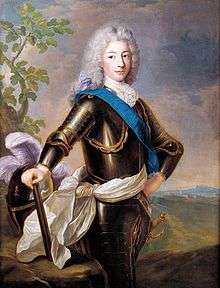
The war in the Alps and the Apennines had already been keenly contested before the Prince of Conti and the Gallispan army had come down out of the Alps. Villefranche and Montalbán had been stormed by Conti on 20 April 1744. After coming down out of the Alps, Prince Conti began his advance into Piedmont on 5 July 1744.[119] On 19 July 1744, the Gallispan army engaged the Sardinian army in some desperate fighting at Peyre-Longue on 18 July 1744.[120] As a result of the battle, the Gallispan army took control of Casteldelfino in the second Battle of Casteldelfino. Conti then moved on to Demonte where on the night of 8–9 August 1744, (a mere 36 hours before the Spanish army in south of Italy fought the second Battle of Velletri, [as noted above]) the Gallispan army took the fortress of Demonte from the Sardinians in the Battle of Demonte.[121] The King of Sardinia was defeated yet again by Conti in a great Battle at Madonna dell'Olmo on 30 September 1744 near Coni (Cuneo).[122] Conti did not, however, succeed in taking the huge fortress at Coni and had to retire into Dauphiné for his winter quarters. Thus, the Gallispan army never did combine with the Spanish army under Count of Gages in the south and now the Austro-Sardinian army lay between them.
The campaign in Italy in 1745 was also no mere war of posts. The Convention of Turin of February 1742 (described above), which established a provisional relationship between Austria and Sardinia had caused some consternation in the Republic of Genoa. However, when this provisional relationship was given a more durable and reliable character in the signing of the Treaty of Worms (1743) signed on 13 September 1743,[123] the government of Genoa became fearful. This fear of diplomatic isolation had caused the Genoese Republic to abandon its neutrality in the war and join the Bourbon cause.[124] Consequently, the Genoese Republic signed a secret treaty with the Bourbon allies of France, Spain and Naples. On 26 June 1745, Genoa declared war on Sardinia.[124]
Empress Maria Theresa, was frustrated with the failure of Lobkowitz to stop the advance of Gage. Accordingly, Lobkowitz was replaced with Count Schulenburg.[125] A change in the command of the Austrians, encouraged the Bourbon allies to strike first in the spring of 1745. Accordingly, Count de Gages moved from Modena towards Lucca, the Gallispan army in the Alps under the new command of Marshal Maillebois (Prince Conti and Marshal Maillebois had exchanged commands over the winter of 1744–1745[126]) advanced through the Italian Riviera to the Tanaro. In the middle of July 1745, the two armies were at last concentrated between the Scrivia and the Tanaro. Together Count de Gage's army and the Gallispan army composed an unusually large number of 80,000 men. A swift march on Piacenza drew the Austrian commander thither and in his absence the allies fell upon and completely defeated the Sardinians at Bassignano on 27 September 1745, a victory which was quickly followed by the capture of Alessandria, Valenza and Casale Monferrato. Jomini calls the concentration of forces which effected the victory "Le plus remarquable de toute la Guerre".[83]

The complicated politics of Italy, however, are reflected in the fact that Count Maillebois was ultimately unable to turn his victory to account. Indeed, early in 1746, Austrian troops, freed by the Austrian peace with Frederick II of Prussia, passed through the Tyrol into Italy. The Gallispan winter quarters at Asti, Italy, were brusquely attacked and a French garrison of 6,000 men at Asti was forced to capitulate.[127] At the same time, Maximilian Ulysses Count Browne with an Austrian corps struck at the allies on the Lower Po, and cut off their communication with the main body of the Gallispan army in Piedmont. A series of minor actions thus completely destroyed the great concentration of Gallispan troops and the Austrians reconquered the duchy of Milan and took possession of much of northern Italy. The allies separated, Maillebois covering Liguria, the Spaniards marching against Browne. The latter was promptly and heavily reinforced and all that the Spaniards could do was to entrench themselves at Piacenza, Philip, the Spanish Infante as supreme commander calling up Maillebois to his aid. The French, skilfully conducted and marching rapidly, joined forces once more, but their situation was critical, for only two marches behind them the army of the King of Sardinia was in pursuit, and before them lay the principal army of the Austrians. The pitched Battle of Piacenza on 16 June 1746 was hard-fought but ended in an Austrian victory, with the Spanish army heavily mauled. That the army escaped at all was in the highest degree creditable to Maillebois and to his son and chief of staff. Under their leadership the Gallispan army eluded both the Austrians and the Sardinians and defeated an Austrian corps in the Battle of Rottofreddo on 12 August 1746.[128] Then the Austrian army made good its retreat back to Genoa.[129]
Although the Austrian army was a mere shadow of its former self, when they returned to Genoa, the Austrians were soon in control of northern Italy. The Austrians occupied the Republic of Genoa on 6 September 1746.[130] But they met with no success in their forays towards the Alps. Soon Genoa revolted from the oppressive rule of the victors, rose and drove out the Austrians on 5–11 December 1746. As an Allied invasion of Provence stalled, and the French, now commanded by Charles Louis Auguste Fouquet, Duc de Belle-Isle, took the offensive (1747).[131] Genoa held out against a second Austrian siege.[132] As usual the plan of campaign had been referred to Paris and Madrid. A picked corps of the French army under the Chevalier de Belle-Isle (the younger brother of Marshal Belle-Isle[131]) was ordered to storm the fortified pass of Exilles on 10 July 1747. However, the defending army of the Worms allies (Austria and Savoy) handed the French army a crushing defeat at this battle, which became known as the (Colle dell'Assietta).[133] At this battle, the chevalier, and with him much of the elite of the French nobility, were killed on the barricades.[133] Desultory campaigns continued between the Worms allies and the French until the conclusion of peace at Aix-la-Chapelle.[134]
The Low Countries, 1745–48

The British and Dutch withdrew from Fontenoy in good order but the French-backed Jacobite rising of August, 1745 forced the British to transfer troops from Flanders to deal with it. By the end of 1745, the French held the strategic towns of Ghent, Oudenarde, Bruges, and Dendermonde, as well as the ports of Ostend and Nieuwpoort, threatening Britain's links to the Low Countries.[135]
During 1746, the French continued their advance into the Austrian Netherlands, taking Antwerp and then clearing Dutch and Austrian forces from the area between Brussels and the Meuse. After defeating the Jacobite Rebellion at Culloden in April, the British launched a diversionary raid on Lorient in an unsuccessful attempt to divert French forces, while the new Austrian commander, Prince Charles of Lorraine, was defeated by Saxe at the Battle of Rocoux in October.[136]
The Dutch Republic itself was now in danger and in April 1747, the French began reducing their Barrier fortresses along the border with the Austrian Netherlands. At Lauffeld on 2 July 1747, Saxe won another victory over a British and Dutch army under the Prince of Orange and Cumberland; the French then besieged Maastricht and Bergen op Zoom, which fell in September.[136]
These events lent greater urgency to ongoing peace talks at the Congress of Breda, which took place to the sound of French artillery firing on Maastricht. Following their 1746 alliance with Austria, an army of 30,000 Russians marched from Livonia to the Rhine, but arrived too late to be of use. Maastricht surrendered on 7 May and on 18 October 1748, the war ended with the signing of the Peace of Aix-la-Chapelle.[137]
The Peace of 1748

Negotiations between Britain and France had been taking place at Breda since June 1746; the terms they agreed were then imposed on the other parties at Aix-la-Chapelle. Despite their victories in Flanders, French Finance Minister Machault repeatedly warned of the impending collapse of their financial system. The British naval blockade led to the collapse of French customs receipts and caused severe food shortages, especially among the poor; after Cape Finisterre in October, the French navy could no longer protect their colonies or trade routes.[138]
This was followed in November by a convention between Britain and Russia; in February 1748, a Russian corps of 37,000 arrived in the Rhineland.[139] Although the Dutch city of Maastricht surrendered to French forces in May 1748, ending the war was increasingly urgent. Louis XV therefore agreed to return the Austrian Netherlands, whose acquisition had cost so much. Few of his countrymen understood this decision; combined with the lack of tangible benefits for helping Prussia, it led to the phrase "as stupid as the Peace".[140]
A commission to negotiate competing territorial claims in North America was set up, but made very little progress. Britain regained Madras, in return for restoring Louisbourg, in Nova Scotia, much to the fury of British colonists. Neither of the two main protagonists appeared to have gained much for their investment and both viewed the Treaty as an armistice, not a peace.[141]
In Austria, reactions were mixed; Maria Theresa was determined to regain Silesia and resented British support for Prussia's occupation.[142] On the other hand, the Treaty confirmed her right to the Monarchy, while the Habsburgs had survived a potentially disastrous crisis, regained the Austrian Netherlands without fighting and made only minor concessions in Italy.[143] Administrative and financial reforms made it stronger in 1750 than 1740, while its strategic position was strengthened through installing Habsburgs as rulers of key territories in Northwest Germany, the Rhineland and Northern Italy.[144]
Of the other combatants, Spain retained its predominance in Spanish America and made minor gains in Northern Italy. With French support, Prussia doubled in size with the acquisition of Silesia but twice made peace without informing their ally; Louis XV already disliked Frederick and now viewed him as untrustworthy. The war confirmed the decline of the Dutch Republic; combined with a sense they received little value for the subsidies paid to Maria Theresa, Britain moved to align itself with Prussia, rather than Austria, in order to protect Hanover from French aggression.[145]
These factors led to the realignment known as the 1756 Diplomatic Revolution and the 1756 to 1763 Seven Years' War, which was even grander in scale than its predecessor.
North America
The war was also conducted in North America and India. In North America the conflict was known in the British colonies as King George's War, and did not begin until after formal war declarations of France and Britain reached the colonies in May 1744. The frontiers between New France and the British colonies of New England, New York, and Nova Scotia were the site of frequent small scale raids, primarily by French colonial troops and their Indian allies against British targets, although several attempts were made by British colonists to organise expeditions against New France. The most significant incident was the capture of the French Fortress Louisbourg on Cape Breton Island (Île Royale) by an expedition (29 April – 16 June 1745) of colonial militia organised by Massachusetts Governor William Shirley, commanded by William Pepperrell of Maine (then part of Massachusetts), and assisted by a Royal Navy fleet. A French expedition to recover Louisbourg in 1746 failed due to bad weather, disease, and the death of its commander. Louisbourg was returned to France in exchange for Madras, generating much anger among the British colonists, who felt they had eliminated a nest of privateers with its capture.
India
.svg.png)

The war marked the beginning of great power in England and the powerful struggle between Britain and France in India and of European military ascendancy and political intervention in the subcontinent. Major hostilities began with the arrival of a naval squadron under Mahé de la Bourdonnais, carrying troops from France. In September 1746 Bourdonnais landed his troops near Madras and laid siege to the port. Although it was the main British settlement in the Carnatic, Madras was weakly fortified and had only a small garrison, reflecting the thoroughly commercial nature of the European presence in India hitherto. On 10 September, only six days after the arrival of the French force, Madras surrendered. The terms of the surrender agreed by Bourdonnais provided for the settlement to be ransomed back for a cash payment by the British East India Company. However, this concession was opposed by Dupleix, the governor general of the Indian possessions of the Compagnie des Indes. When Bourdonnais was forced to leave India in October after the devastation of his squadron by a cyclone Dupleix reneged on the agreement. The Nawab of the Carnatic Anwaruddin Muhammed Khan intervened in support of the British and advanced to retake Madras, but despite vast superiority in numbers his army was easily and bloodily crushed by the French, in the first demonstration of the gap in quality that had opened up between European and Indian armies.
The French now turned to the remaining British settlement in the Carnatic, Fort St. David at Cuddalore, which was dangerously close to the main French settlement of Pondichéry. The first French force sent against Cuddalore was surprised and defeated nearby by the forces of the Nawab and the British garrison in December 1746. Early in 1747 a second expedition laid siege to Fort St David but withdrew on the arrival of a British naval squadron in March. A final attempt in June 1748 avoided the fort and attacked the weakly fortified town of Cuddalore itself, but was routed by the British garrison.
With the arrival of a naval squadron under Admiral Boscawen, carrying troops and artillery, the British went on the offensive, laying siege to Pondichéry. They enjoyed a considerable superiority in numbers over the defenders, but the settlement had been heavily fortified by Dupleix and after two months the siege was abandoned.
The peace settlement brought the return of Madras to the British company, exchanged for Louisbourg in Canada. However, the conflict between the two companies continued by proxy during the interval before the outbreak of the Seven Years' War, with British and French forces fighting on behalf of rival claimants to the thrones of Hyderabad and the Carnatic.
Naval operations
The naval operations of this war were entangled with the War of Jenkins' Ear, which broke out in 1739 in consequence of the long disputes between Britain and Spain over their conflicting claims in America.[134] The war was remarkable for the prominence of privateering on both sides. It was carried on by the Spaniards in the West Indies with great success, and actively at home. The French were no less active in all seas. Mahé de la Bourdonnais's attack on Madras partook largely of the nature of a privateering venture. The British retaliated with vigour. The total number of captures by French and Spanish corsairs was in all probability larger than the list of British—as the French wit Voltaire drolly put it upon hearing his government's boast, namely, that more British merchants were taken because there were many more British merchant ships to take; but partly also because the British government had not yet begun to enforce the use of convoy so strictly as it did in later times.[146]
West Indies
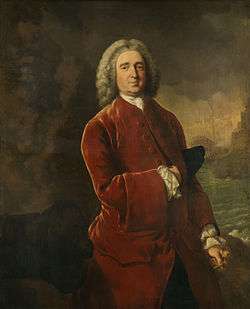
War on Spain was declared by Great Britain on 23 October 1739, which has become known as the War of Jenkins' Ear. A plan was laid for combined operations against the Spanish colonies from east and west. One force, military and naval, was to assault them from the West Indies under Admiral Edward Vernon. Another, to be commanded by Commodore George Anson, afterwards Lord Anson, was to round Cape Horn and to fall upon the Pacific coast of Latin America. Delays, bad preparations, dockyard corruption, and the squabbles of the naval and military officers concerned caused the failure of a hopeful scheme. On 21 November 1739, Admiral Vernon did, however, succeed in capturing the ill-defended Spanish harbour of Porto Bello in present-day Panama. When Vernon had been joined by Sir Chaloner Ogle with massive naval reinforcements and a strong body of troops, an attack was made on Cartagena de Indias in what is now Colombia (9 March – 24 April 1741). The delay had given the Spanish under Sebastián de Eslava and Blas de Lezo time to prepare. After two months of skilful defence by the Spanish, the British attack finally succumbed to a massive outbreak of disease and withdrew having suffered a dreadful loss of lives and ships.[147]
The war in the West Indies, after two other unsuccessful attacks had been made on Spanish territory, died down and did not revive until 1748. The expedition under Anson sailed late, was very ill-provided, and less strong than had been intended. It consisted of six ships and left Britain on 18 September 1740. Anson returned alone with his flagship the Centurion on 15 June 1744. The other vessels had either failed to round the Horn or had been lost. But Anson had harried the coast of Chile and Peru and had captured a Spanish galleon of immense value near the Philippines. His cruise was a great feat of resolution and endurance.[146]
After the failure of the British invasions and a Spanish counter invasion of Georgia in 1742, belligerent naval actions in the Caribbean were left to the privateers of both sides. Fearing great financial and economic losses should a treasure fleet be captured, the Spanish reduced the risk by increasing the number of convoys, thereby reducing their value. They also increased the number of ports they visited and reduced the predictability of their voyages.
In 1744 300 British militia, slaves and regulars with two privateers from Saint Kitts invaded the French half of neighbouring Saint Martin, holding it until the 1748 Treaty of Aix-la-Chapelle. In late May 1745 two French royal frigates of 36 and 30 guns respectively under Commodore La Touché, plus three privateers in retaliation sailed from Martinique to invade and capture Anguilla but were repelled with heavy loss.
The last year of the war saw two significant actions in the Caribbean. A second British assault on Santiago de Cuba which also ended in failure and a naval action which arose from an accidental encounter between two convoys. The action unfolded in a confused way with each side at once anxious to cover its own trade and to intercept that of the other. Capture was rendered particularly desirable for the British by the fact that the Spanish homeward-bound fleet would be laden with bullion from the American mines.[146] The advantage lay with the British when one Spanish warship ran aground and another was captured but the British commander failed to capitalise and the Spanish fleet took shelter in Havana.
Mediterranean

While Anson was pursuing his voyage round the world, Spain was mainly intent on the Italian policy of the King. A squadron was fitted out at Cádiz to convey troops to Italy. It was watched by the British admiral Nicholas Haddock. When the blockading squadron was forced off by want of provisions, the Spanish admiral Don Juan José Navarro put to sea. He was followed, but when the British force came in sight of him Navarro had been joined by a French squadron under Claude-Elisée de La Bruyère de Court (December 1741). The French admiral announced that he would support the Spaniards if they were attacked and Haddock retired. France and Great Britain were not yet openly at war, but both were engaged in the struggle in Germany—Great Britain as the ally of the Queen of Hungary, Maria Theresa; France as the supporter of the Bavarian claimant of the empire. Navarro and de Court went on to Toulon, where they remained until February 1744. A British fleet watched them, under the command of Admiral Richard Lestock, until Sir Thomas Mathews was sent out as commander-in-chief and as Minister to the Court of Turin.[147]
Sporadic manifestations of hostility between the French and British took place in different seas, but avowed war did not begin until the French government issued its declaration of 30 March, to which Great Britain replied on 31 March. This formality had been preceded by French preparations for the invasion of England, and by the Battle of Toulon between the British and a Franco-Spanish fleet. On 11 February, a most confused battle was fought, in which the van and centre of the British fleet was engaged with the Spanish rear and centre of the allies. Lestock, who was on the worst possible terms with his superior, took no part in the action. Mathews fought with spirit but in a disorderly way, breaking the formation of his fleet, and showing no power of direction, while Navarro's smaller fleet retained cohesion and fought off the energetic but confused attacks of its larger enemy until the arrival of the French fleet forced the heavily damaged British fleet to withdraw. The Spanish fleet then sailed to Italy where it delivered a fresh army and supplies that had a decisive impact upon the war. The mismanagement of the British fleet in the battle, by arousing deep anger among the people, led to a drastic reform of the British navy.[147]
Northern waters
The French scheme to invade Britain was arranged in combination with the Jacobite leaders, and soldiers were to be transported from Dunkirk. In February 1744, a French fleet of twenty sail of the line entered the English Channel under Jacques Aymar, comte de Roquefeuil, before the British force under Admiral John Norris was ready to oppose him. But the French force was ill-equipped, the admiral was nervous, his mind dwelt on all the misfortunes which might possibly happen, and the weather was bad. De Roquefeuil came up almost as far as The Downs, where he learnt that Sir John Norris was at hand with twenty-five sail of the line, and thereupon precipitately retreated. The military expedition prepared at Dunkirk to cross under cover of De Roquefeuil's fleet naturally did not start. The utter weakness of the French at sea, due to long neglect of the fleet and the bankrupt state of the treasury, was shown during the Jacobite rising of 1745, when France made no attempt to profit by the distress of the British government.[147]
The Dutch, having by this time joined Great Britain, made a serious addition to the naval power opposed to France, though the Dutch Republic was compelled by the necessity for maintaining an army in Flanders to play a very subordinate part at sea. Not being stimulated by formidable attack, and having immediate interests both at home and in Germany, the British government was slow to make use of its latest naval strength. Spain, which could do nothing of an offensive character, was almost neglected. During 1745 the New England expedition which took Louisburg (30 April – 16 June) was covered by a British naval force, but little else was accomplished by the naval efforts of any of the belligerents.[147]
In 1746 a British combined naval and military expedition to the coast of France—the first of a long series of similar ventures which in the end were derided as "breaking windows with guineas"—was carried out during August and October. The aim was the capture of the French East India Company's dockyard at Lorient, but it was not attained.[148][147]
From 1747 until the close of the war in October 1748, the naval policy of the British government, without reaching a high level, was more energetic and coherent. A closer watch was kept on the French coast, and effectual means were taken to intercept communication between France and her American possessions. In the spring information was obtained that an important convoy for the East and West Indies was to sail from L'Orient.[147] The convoy was intercepted by Anson on 3 May, and in the first Battle of Cape Finisterre, British admiral George Anson's fourteen ships of the line wiped out the French escort of six ships of the line and three armed Indiamen, although in the meantime the merchant ships escaped.
On 14 October, another French convoy, protected by a strong squadron, was intercepted by a well-appointed and well-directed squadron of superior numbers—the squadrons were respectively eight French and fourteen British—in the Bay of Biscay. In the second Battle of Cape Finisterre which followed, the French admiral, Henri-François des Herbiers-l'Étenduère, succeeded in covering the escape of most of the merchant ships, but Hawke's British squadron took six of his warships. Most of the merchantmen were later intercepted and captured in the West Indies. This disaster convinced the French government of its helplessness at sea, and it made no further effort.[147]
Indian Ocean
In the East Indies, attacks on French commerce by a British squadron under Curtis Barnett in 1745 led to the despatch of a French squadron commanded by Mahé de la Bourdonnais. After an inconclusive clash off Negapatnam in July 1746, Edward Peyton, Barnett's successor, withdrew to Bengal, leaving Bourdonnais unopposed on the Coromandel Coast. He landed troops near Madras and besieged the port by land and sea, forcing it to surrender on 10 September 1746. In October the French squadron was devastated by a cyclone, losing four ships of the line and suffering heavy damage to four more, and the surviving ships withdrew. French land forces went on to make several attacks on the British settlement at Cuddalore, but the eventual replacement of the negligent Peyton by Thomas Griffin resulted in a return to British naval supremacy which put the French on the defensive. Despite the appearance of another French squadron, the arrival of large-scale British reinforcements under Edward Boscawen (who considered but did not make an attack on Île de France on the way) gave the British overwhelming dominance on land and sea, but the ensuing siege of Pondichéry organised by Boscawen was unsuccessful.
Strength of armies 1740
| Belligerent | Foot | Horse Dragoons |
Artillery | Engineers | Others | Militia | Sources |
|---|---|---|---|---|---|---|---|
| Austria | 76,000 | 32,000 | 2,600 | 150 | 0 | .. | [149] |
| Bavaria | 36,000 | 4,000 | 200 | 0 | 0 | .. | [150] |
| France | 111,000 | 19,000 | 3,000 | .. | 0 | 30,000 | [151] |
| Great Britain | 19,000 | 7,000 | 2,000 | .. | 6,000[lower-alpha 1] | 130,000 | [152] |
| Hanover | 18,000 | 5,000 | 360 | 23 | 0 | 0 | [153] |
| Hesse-Kassel | 18,000 | 4,000 | 900 | .. | .. | 0 | [154] |
| Cologne | 1,000 | 0 | 0 | 0 | 0 | 0 | [155] |
| Palatinate | 9,000 | 1,000 | 200 | 15 | 0 | 0 | [156] |
| Prussia | 76,000 | 22,000 | 1,200 | 43 | 0 | 0 | [157] |
| Savoy-Sardinia | 41,000 | 5,000 | .. | .. | 0 | 0 | [158] |
| Saxony | 20,000 | 8,800 | 600 | 0 | 0 | 0 | [159] |
Related wars
- First Silesian War (1740–1742) — Prussian invasion and ensuing Central European theatre of the war
- Second Silesian War (1744–1745) — Renewed Prussian invasion and continuation of First Silesian War
- First Carnatic War — Anglo-French rivalry in India often seen as a theatre of the War of the Austrian Succession.
- Russo-Swedish War (1741–43) — Swedish and Russian participation in the War of the Austrian Succession.
- King George's War — American participation in the War of the Austrian Succession.
- War of Jenkins' Ear — Anglo-Spanish war which merged into the War of the Austrian Succession.
- Jacobite rising of 1745 — France provided limited support to Charles Edward Stuart's invasion of Great Britain.
Gallery
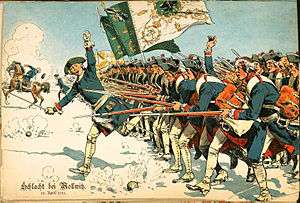 The Prussian infantry during the Battle of Mollwitz, 1741
The Prussian infantry during the Battle of Mollwitz, 1741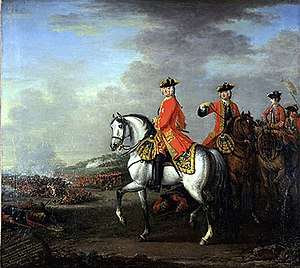 King George II at the Battle of Dettingen, 1743
King George II at the Battle of Dettingen, 1743 The Duke of Lorraine and Imperial troops crossing the Rhine before Strasbourg, 1744
The Duke of Lorraine and Imperial troops crossing the Rhine before Strasbourg, 1744 View of the British landing on the island of Cape Breton to attack the fortress of Louisbourg, 1745
View of the British landing on the island of Cape Breton to attack the fortress of Louisbourg, 1745 The British fleet bombarding the Corsican port of Bastia in 1745
The British fleet bombarding the Corsican port of Bastia in 1745- The Battle of Fontenoy, 11 May 1745
 Colonels of the French Guards and British guards politely discussing who should fire first at the battle of Fontenoy, 1745
Colonels of the French Guards and British guards politely discussing who should fire first at the battle of Fontenoy, 1745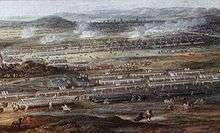 The Battle of Rocoux in 1746, between the French and the British, Dutch and Austrians
The Battle of Rocoux in 1746, between the French and the British, Dutch and Austrians The Battle of Cape Finisterre, 1747
The Battle of Cape Finisterre, 1747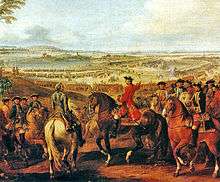 Marshal Maurice de Saxe at the Battle of Lauffeld, 1747
Marshal Maurice de Saxe at the Battle of Lauffeld, 1747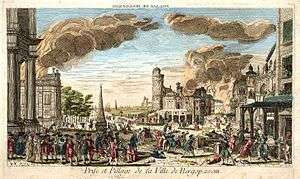 Taking and looting of the fortress of Bergen-op-Zoom in 1747
Taking and looting of the fortress of Bergen-op-Zoom in 1747
See also
| Wikimedia Commons has media related to War of the Austrian Succession. |
Notes
- Statistics of Wars, Oppressions and Atrocities of the Eighteenth Century
- Clodfelter 2017, pp. 78.
- Anderson 1995, pp. 7-9.
- Ingrao 2000, p. 129.
- Holborn 1982, p. 108.
- Horn 1929, pp. 33–37.
- Anderson 1995, p. 3.
- Black 1999, p. 82.
- Coxe 1847, p. 242.
- Browning, Reed S. (1994). War of the Austrian Succession. Oxford University Press. ISBN 978-0-750-90578-7. Retrieved 10 February 2019.
- Pritchard, James (2004). In Search of Empire: The French in the Americas, 1670–1730. Cambridge: Cambridge University Press. p. 356. ISBN 978-0-521-82742-3.
- Dull, Jonathan R. (2007). The French Navy and the Seven Years' War. Lincoln (NE): University of Nebraska Press. p. 14. ISBN 978-0-803-21731-7.
- Borneman, Walter R. (2007). The French and Indian War: Deciding the Fate of North America. New York (NY): HarperCollins. p. 80. ISBN 978-0-060-76184-4.
- Lee 1984, p. 285.
- Till 2006, p. 77.
- Black 1999, p. 45.
- Vego 2003, pp. 156–157.
- Black (1994b), pp. 38–52
- Black (1994b), pp. 67–80
- Clark (2006), p. 209
- Creveld (1977), pp. 26–28
- Luvaas, p. 3
- Davies, p. 507
- Asprey, p. 697
- Browning, p. 24
- Black 1994, p. 62.
- Browning, p. 20
- Asprey, p. 129
- Asprey, p. 164
- Anderson, p. 68
- Armour, pp. 99-101
- Anderson, pp. 69-72
- Luvaas 1966, p. 46.
- Black 1998, p. 13.
- Asprey 1986, p. 223.
- Hannay 1911, p. 40.
- Anderson 1995, p. 86.
- Anderson 1995, p. 89.
- Anderson 1995, p. 88.
- Anderson 1995, p. 94.
- Showalter 2012, p. 22.
- Asprey 1986, p. 208.
- Duffy 2015, pp. 39.
- Browning 1975, p. 103.
- Berry.
- Mitchell 2018, p. 170.
- Showalter 2012, p. 27.
- Asprey 1986, p. 274.
- Anderson 1995, p. 114.
- Browning 1993, p. 136.
- Browning 1995, p. 136.
- De Périni 1896, p. 295.
- Anderson 1995, pp. 117-118.
- Asprey 1986, p. 275.
- Anderson 1995, p. 128.
- Lincoln 1981, p. 197.
- Hochedlinger 2003, p. 255.
- Anderson 1995, pp. 126-127.
- Asprey, p. 279
- Hannay 1911, p. 41.
- McLaren, p. 23
- McLaren, p. 33
- Browning, p. 155
- Smith, p. 243
- Asprey, p. 280
- Browning, p. 171
- Browning, p. 172
- Browning, pp. 172, 174
- Carlyle
- Browning, p. 174
- Browning, p. 173
- Browning, p. 175
- Hannay 1911, pp. 41–42.
- Asprey, p. 289
- Asprey, p. 290
- Browning, p. 181
- Luvaas, p. 4
- Asprey, p. 293
- Asprey, pp. 293–294
- Browning, p. 182
- Browning, p. 183
- Browning, p. 196
- Hannay 1911, p. 42.
- Browning, p. 195
- Browning, p. 203
- Browning, p. 206
- Browning, p. 207
- Browning, p. 208
- Browning, p. 212
- Browning, pp. 212–213
- Browning, p. 219
- McLaren, p. 39
- Browning, p. 240
- Browning, p. 241
- Magnusson, Magnus (2000). Scotland: The Story of a Nation. New York (NY): Grove Press. p. 594.
- Browning, p. 242
- Magnusson, p. 601
- Magnusson, p. 603
- Magnusson, p. 616
- Magnusson, pp. 607–608
- Browning, p. 263
- Asprey, p. 317
- Luvaas, p. 5
- Asprey, p. 323
- Asprey, p. 333
- Browning, p. 96
- Browning, p. 97
- Browning, p. 118
- Browning, p. 119
- Browning, pp. 132–133
- Cranston, Maurice (1991). Jean-Jacques: The Early Life and Work of Jean-Jacques Rousseau, 1712–1754. Chicago (IL): University of Chicago Press. p. 183. ISBN 0-226-11862-2.
- Smith, pp. 200–201.
- Smith, pp. 231–233.
- Browning, p. 166
- Browning, p. 167
- Browning, p. 163
- Browning, p. 164
- Browning, p. 165
- Browning, p. 168
- Browning, pp. 168–169
- Browning, p. 169
- Browning, pp. 186–188
- Browning, pp. 142–143
- Browning, p. 205
- Browing, p. 231
- Browning, p. 204
- Browning, p. 262
- Browning, p. 287
- Hannay 1911, pp. 42–43.
- Browning, pp. 287–288
- Browning, p. 311
- Browning, p. 313
- Browning, p. 312
- Hannay 1911, p. 43.
- Tucker, Spencer C., ed. (2009). A Global Chronology of Conflict: From the Ancient World to the Modern Middle East. Santa Barbara (CA): ABC-CLIO. p. 746. ISBN 978-1-851-09667-1.
- Tucker, p.753
- Tucker, p.755-756
- Black (1999), pp. 97-100
- Hochedlinger, Michael; Austria's Wars of Emergence, 1683–1797, Longman, London, 2003, p. 259
- McLynn, p. 1
- McLynn, p. 2
- McGill, W. J. (1971). "The Roots of Policy: Kaunitz in Vienna and Versailles, 1749–53". Journal of Modern History (43): 229.
- Armour, pp.99-101
- Black (1994), p. 63
- Browning, p. 150
- Hannay 1911, p. 45.
- Hannay 1911, p. 44.
- Harding
- K. und K. Kriegsarchiv (1896); Oesterreichischer Erbfolge-Krieg, vol. 1:1, Verlag L. W. Seidel & Sohn, Wien, pp. 372, 432–434, 444–445
- K. und K. Kriegsarchiv (1896), vol. 1:1, pp. 589–590
- K. und K. Kriegsarchiv (1896), vol. 1:1, pp. 639, 642
- K. und K. Kriegsarchiv (1896), vol. 1:1, pp. 620–621, 626–627
- K. und K. Kriegsarchiv (1896), vol. 1:1, pp. 610–611
- K. und K. Kriegsarchiv (1896), vol. 1:1, p. 605
- K. und K. Kriegsarchiv (1896), vol. 1:1, p. 602
- K. und K. Kriegsarchiv (1896), vol. 1:1, p. 601
- K. und K. Kriegsarchiv (1896), vol. 1:1, p. 573
- K. und K. Kriegsarchiv (1896), vol. 1:1, pp. 661–662
- K. und K. Kriegsarchiv (1896), vol. 1:1, pp. 585–586
Sources
- Anderson, Matthew Smith (1995). The War of the Austrian Succession 1740–1748. Routledge. ISBN 978-0-582-05950-4.CS1 maint: ref=harv (link)
- Armour, Ian (2012). A History of Eastern Europe 1740–1918. Bloomsbury Academic Press. ISBN 978-1-849-66488-2.CS1 maint: ref=harv (link)
- Asprey, Robert B. (1986). Frederick the Great; The Magnificent Enigma (Revised 2007 ed.). iUniverse. ISBN 978-0-595-46900-0.CS1 maint: ref=harv (link)
- Black, Jeremy (1994). British Foreign Policy in an Age of Revolutions, 1783-1793. Cambridge University Press. ISBN 978-0-521-45001-0.CS1 maint: ref=harv (link)
- Black, Jeremy (1994b). European Warfare, 1660–1815. London: UCL Press. ISBN 978-1-85728-172-9.CS1 maint: ref=harv (link)
- Black, Jeremy (1998). America or Europe?: British Foreign Policy, 1739–63. University College London Press. ISBN 0-203-49947-6.
- Browning, Reed S. (1993). The War of the Austrian Succession. New York (NY): St.Martin's Press. ISBN 978-0-312-09483-6.CS1 maint: ref=harv (link)
- Carlyle, Thomas (1873). History of Friedrich II of Prussia, called Frederick the Great. V. London. "Archived copy". Archived from the original on 12 January 2009. Retrieved 13 August 2008.CS1 maint: archived copy as title (link) Book XV: Second Silesian War, Important Episode in the General European one. 15 August 1744 – 25 December 1745., chapter 1: Section: Prince Charles gets across the Rhine (20 June – 2 July 1744), Project Gutenberg
- Chandler, David (1990). The Art of Warfare in the Age of Marlborough. Spellmount Limited. ISBN 0-946771-42-1.
- Clark, Christopher (2006). Iron Kingdom: The Rise and Downfall of Prussia, 1600–1947. Belknap Press. ISBN 978-0-674-03196-8.CS1 maint: ref=harv (link)
- Coxe, William (2010). History of the House of Austria (1847 ed.). Nabu Publishing. ISBN 978-1-148-32947-5.CS1 maint: ref=harv (link)
- Creveld, Martin van (1977). Supplying War: Logistics from Wallenstein to Patton. Cambridge University Press. ISBN 978-0-521-21730-9.CS1 maint: ref=harv (link)
- Davies, Norman (1982). God's Playground: A History of Poland; Volume 1: The Origins to 1795 (2005 ed.). Oxford University Press. ISBN 978-0-199-25339-5.
- * De Jomini, General Baron Antoine Henri (1862). Treatise on grand military operations. I. New York (NY).CS1 maint: ref=harv (link)
- Duffy, Christopher (2015). Frederick the Great: A Military Life. Routledge. ISBN 978-1138924659.CS1 maint: ref=harv (link)
- Fortescue, Sir John William (1899). A History of the British Army. II. London: MacMillan.

- Harding, Richard (2010). The Emergence of Britain's Global Naval Supremacy: The War of 1739–1748. Boydell and Brewer. ISBN 9781843835806. JSTOR 10.7722/j.ctt14brrf4.CS1 maint: ref=harv (link)
- Hochedlinger, Michael (2003). Austria's Wars of Emergence, 1683-1797 (Modern Wars In Perspective). Routledge. ISBN 978-0582290846.CS1 maint: ref=harv (link)
- Holborn, Hajo (1982). A History of Modern Germany, Volume 2: 1648–1840: 1648–1840 v. 2. Princeton University Press. ISBN 978-0-691-00796-0.CS1 maint: ref=harv (link)
- Horn, David Bayne (1929). "Saxony in the War of the Austrian Succession". The English Historical Review. 44 (173): 33–47. doi:10.1093/ehr/XLIV.CLXXIII.33. JSTOR 552493.CS1 maint: ref=harv (link)
- Ingrao, Charles (2000). The Habsburg Monarchy, 1618–1815 (New Approaches to European History). Cambridge University Press. ISBN 978-0-521-78034-6.CS1 maint: ref=harv (link)
- Lee, Stephen J. (1984). Aspects of European History, 1494–1789. London: Routledge. ISBN 978-0-416-37490-2.CS1 maint: ref=harv (link)
- Lincoln, W. Bruce (1981). The Romanovs: Autocrats of All the Russias. New York (NY): The Dial Press.CS1 maint: ref=harv (link)
- Luvaas, Jay (1966). Frederick the Great on the Art of War. Free Press. ISBN 978-1-111-78540-6.
- Mahan, J. Alexander (1932). Maria Theresa of Austria. New York (NY): Thomas Y. Crowell Pub.CS1 maint: ref=harv (link)
- McLaren, Moray (1972). Bonnie Prince Charlie. New York (NY): Dorset Press.CS1 maint: ref=harv (link)
- McLynn, Frank (2008). 1759: The Year Britain Became Master of the World. Vintage. ISBN 978-0-099-52639-1.CS1 maint: ref=harv (link)
- Paoletti, Ciro (2017). "The Battle of Culloden: A Pivotal Moment in World History". Journal of Military History. 81 (1).
- Rodger, Brendan (2005). The Command of the Ocean: A Naval History of Britain 1649-1815. W. W. Norton & Company. ISBN 978-0-393-06050-8.CS1 maint: ref=harv (link)
- Showalter, Dennis (2012). Frederick the Great: A Military History. Frontline Books. ISBN 978-1848326408.CS1 maint: ref=harv (link)
- Smith, Rhea Marsh (1965). Spain: A Modern History. Ann Arbor (MI): University of Michigan Press.
- Thomson, Mark A. (1957). The War of the Austrian Succession, in The New Cambridge Modern History, Volume VII. Cambridge University Press.CS1 maint: ref=harv (link)
- Till, Geoffrey (2006). Development of British Naval Thinking: Essays in Memory of Bryan Ranft. Routledge. ISBN 978-0-714-65320-4.CS1 maint: ref=harv (link)
- Vego, Milan N. (2003). Naval Strategy and Operations in Narrow Seas. Frank Cass. ISBN 978-0-714-65389-1.CS1 maint: ref=harv (link)
- Young, Patricia T.; Levy, Jack S. (2011). "Domestic politics and the escalation of commercial rivalry: Explaining the War of Jenkins' Ear, 1739–48". European Journal of International Relations. 17 (2): 209–232. doi:10.1177/1354066109350054.CS1 maint: ref=harv (link)
